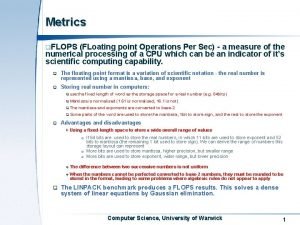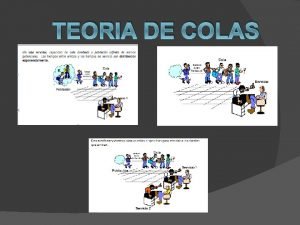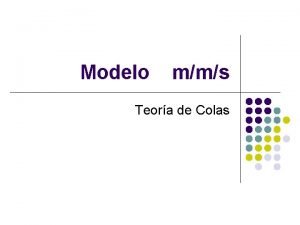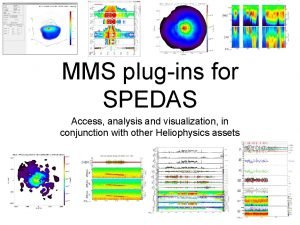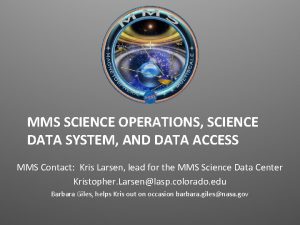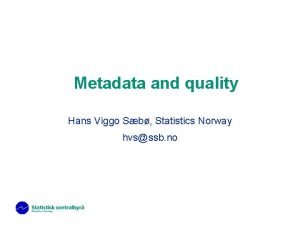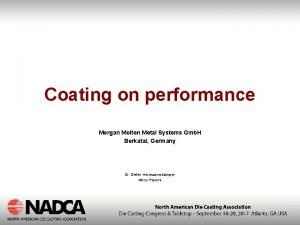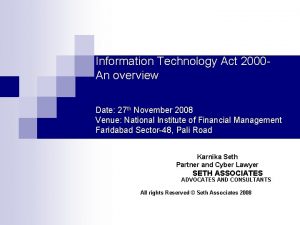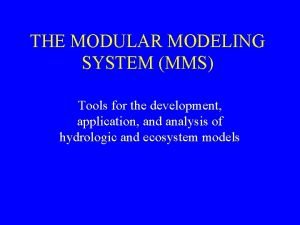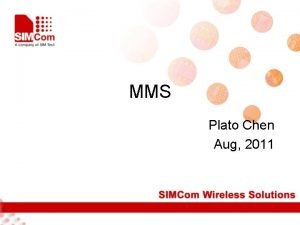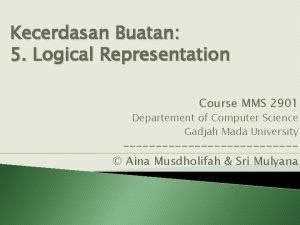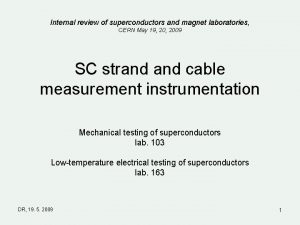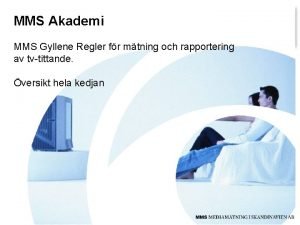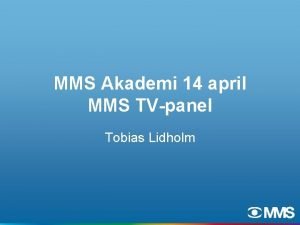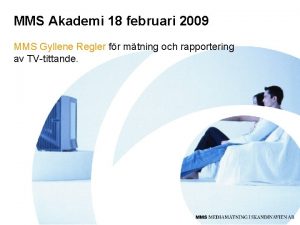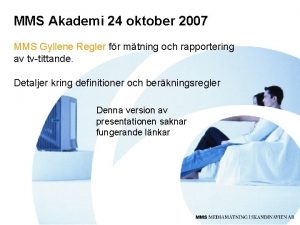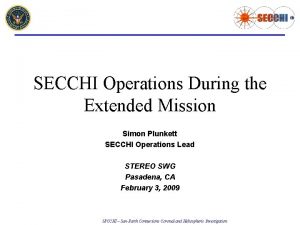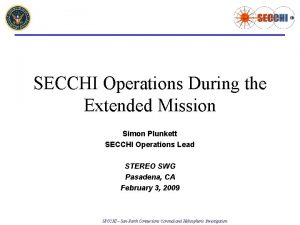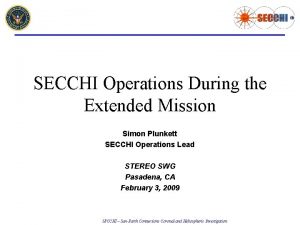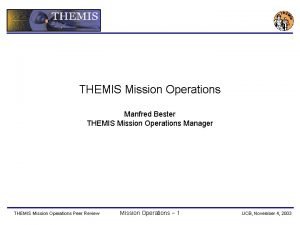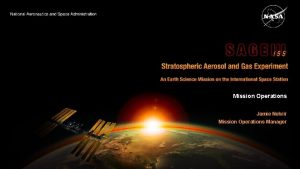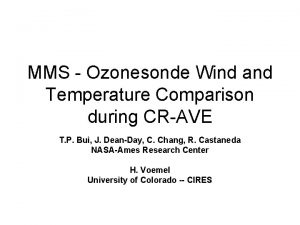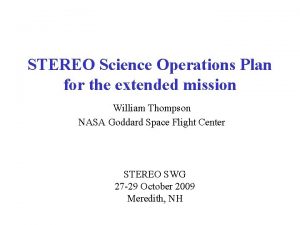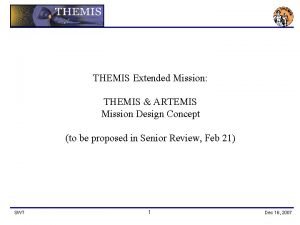Mission Operations During the Second MMS Extended Mission



























- Slides: 27

Mission Operations During the Second MMS Extended Mission Jim Clapsadle, Trevor Williams NASA Goddard Space Flight Center MMS Science Working Team Virtual Meeting Oct. 6 -8, 2020

Mission Operations During Extended Mission - 1 • MMS nominal operations through End of Mission (2030) includes formation maintenance, formation resizes for science, apogee adjusts, perigee adjust, long duration eclipses and non-tetrahedral campaigns – Formation Maintenance: • Around 4 maintenance activities per year, triggered by formation quality or safety – Formation Resizes for science: • Resizing between the dayside and the nightside (typically 20 to 40 km; other sizes can be accommodated with a lead time of at least 2 months) occurs twice per year – Apogee-adjust maneuvers: tweak long duration eclipses to make the two in each “eclipse season“ of equal duration, so minimizing the maximum • Sept. 25, 2021 (period increased 21. 3 min) • Sept. 30, 2022 (period decreased 20. 6 min) • Oct. 12, 2025 (period increased 24. 8 min) • Oct. 11, 2026 (period decreased 30. 0 min) • Oct. 14, 2027 (period decreased 15. 4 min) These small burns are performed essentially simultaneously, on a single perigee passage, while still in formation. For safety, a relatively large tetrahedron is required, e. g. the 40 km nightside formation size Oct. 6 -8, 2020 2

Mission Operations During Extended Mission - 2 – Apogee-adjust maneuvers (continued) • To minimize the disruption to science, these maneuvers have been scheduled for near the end of nightside phases, when already in a large formation, and about 3 weeks before the transition to the smaller dayside scale size. There should be some flexibility in the proposed dates, if they are not optimal for science: any changes affect DSN scheduling though, so as least 10 months notice is needed – Perigee-raise maneuver: to keep perigee altitude above the 700 km limit. This will probably require time (e. g 1 month) out of formation • Scheduled for Nov. 1, 2023 – Long eclipses (defined as above 4 hr, umbra plus half penumbra): • • Two in Aug. 2021 (~4. 7 hr) Two in Aug. 2022 (~4. 4 hr) [2023, 2024: eclipses reminiscent of those in prime mission] Two in Sept. 2025 (~4. 9 hr) Two in Sept. 2026 (~4. 4 hr) Two in Aug. /Sept. 2027 (~4. 4 hr) Two in Aug. 2028 (~4. 5 hr) – Note that all of these are shorter than the Aug. 2020 long eclipses Oct. 6 -8, 2020 3

Mission Operations During Extended Mission - 3 – Non-tetrahedral formation campaigns: • Goal is to support new MMS science, for instance in the cusps • For definiteness, the specific non-tetrahedral string campaigns described below were assumed here, based on what is given in the Senior Review proposal. (Additional campaigns would require at least 8 months notice. ) The fuel numbers provided later technically apply only for this specific case, but should be representative of other possible sequences as well • Sequence: three logarithmic string campaigns, 2023 -2025: Oct. 6 -8, 2020 - Each has string size {30, 650, 15, 000 km}, defined at 12 RE rather than at apogee (to be appropriate for cusp science) - Each string campaign lasts approx. 9 months - The spacecraft are then put back into a “typical” tetrahedral formation for approx. 3 months, for the long(ish) eclipses for these years - Fuel used in each year of a string campaign: o 1 -5 kg/MMS to set up string and then return from it o 0 -3 kg/MMS for string maintenance over 9 months o 1 kg/MMS to maintain/resize tetrahedron over 3 months o Total: 2 -9 kg/MMS [Note: fuel balancing should be able to moderate this range of fuel consumptions, so reducing the maximum] After 2025, MMS is assumed to return to flying in tetrahedral formations for the neutral sheet encounters that occur until reentry in 2030 4

Baseline Plus Micro-ARs: Peri Altitude Minimum 702 km in Feb. , 2024; reentry 2030 June 5, 2018 5

Feasible Non-Tetrahedral Formations • A key question: what formation geometries can persist for long periods of time under orbital mechanics? (This assumes that small maintenance burn are performed periodically to compensate for perturbations and execution errors in previous maneuvers) • To study this, three different initial separation directions were considered, and the resulting relative motion examined. These directions were: – Along the velocity vector – Out-of-plane, i. e. along the orbit normal – Along the binormal direction (coincident with radial at apogee) • Important point: separation along orbital radius only possible for very brief periods! • Plots summarizing this behavior are provided in the backup slides which show a resulting set of long-term non-tetrahedral formation geometries: these specify the orientations of possible formations • The next slides show the constraints on the size and shape of such formations that arise from MMS operational and/or safety considerations 6 Oct. 6 -8, 2020

Non-Tetrahedral Design Constraints Parameter Value if string defined at apogee Value if string Reason defined at 12 RE (i. e. ~ MP) Minimum along-track spacing 15 km 83 km Safety at apogee (string closest approach point) Maximum along-track spacing for direct insertion into string 100 km 560 km Fuel (~10 kg per obs. ) Maximum along-track spacing for drift into string over 1 month (one way) 0. 9 RE 5. 0 RE For max apo-change of 0. 1 RE (to not corrupt eclipse geometry), all performed by one MMS Maximum along-track spacing for drift into string over 2 months (one way) 1. 8 RE 10. 1 RE Ditto Tightest specified relative tolerance on along-track spacing that gives at least 2 weeks between maintenance maneuvers 4% 4% Driven by effects of differential lunisolar perturbations Tightest specified relative tolerance on along-track spacing that gives at least 4 weeks between maintenance maneuvers 7% 7% Ditto Maximum out-of-plane (OOP) spacing in dumbbell or kite 50 km 18 km Oct. 6 -8, 2020 Prevents perturbations from driving OOP errors above ± 5 km in 2 weeks 7

Result: Feasible Formation Geometries • (A) Basic strings (possibly with wide range of inter-satellite spacings). Notes: string must lie along orbital velocity vector • (B) Strings with additional cross-member(s). Note: these must lie along orbit normal, not radius, if formation shape is to persist. Examples: – String with crossmember at each end (“Dumbbell“): Velocity – String with single crossmember (“Kite“): Orbit normal – String with triangle at one end (“Sword“ - string lies in plane of triangle): Oct. 6 -8, 2020 8

Fuel Estimates, Extended Mission End of Mission in 2030 Event Fuel used per spacecraft (kg) Minimum fuel remaining per spacecraft (kg) Current fuel {124, 121, 121 kg} (bookkeeping, as of 8/11/2020) -- 121 Tetrahedron formation flight to mid-2023 (3 yr @ 1. 5 kg/MMS/yr) 5 116 Apogee-adjusts (eclipse tweaking), Sept. 2020 -2023 1 115 Perigee-raise to keep above 700 km threshold, 2023 6 109 Logarithmic string campaigns, 2023 -2025 (3 yr @ 2 -9 kg/MMS/yr) 6 -27 82 Apogee-adjust (eclipse tweaking), 2027 1 81 Tetrahedron formation flight, 2025 -2030 reentry (5 yr @ 1. 5 kg/MMS/yr) 8 73 Possible Dodge maneuver/recovery (x 2) 2 71 End of mission (EOM) dephasing/disposal 2 69 Unusable in tanks/lines at EOM 2 67 => Remaining usable fuel at End of Mission, 2030 -- 67 Oct. 6 -8, 2020 9

Options for Delaying End of Mission • Reentry currently occurs naturally in 2030. The spacecraft are predicted to still have at least 67 kg fuel remaining at reentry • A portion of this fuel reserve could be used, if desired, to delay reentry beyond 2030. If this is done though, it should be noted that the spacecraft do not reenter for as long as the orbits can reliably be propagated: ~100 years! This obviously violates the 25 -year orbital debris mitigation rule. Reentry would have to be forced: the next good opportunity is at the next dip in the perigee graph in early 2037 • Required maneuvers and fuel required: – – – Perigee-raise 1 to prevent reentry in 2030: late 2029; 8 kg Perigee-raise 2 to prevent reentry in 2030: early 2030; 8 kg Perigee-lowering 1 to cause reentry in 2037: Feb. 2036; 8 kg Perigee-lowering 2 to cause reentry in 2037: Oct. 2036; 13 kg Total fuel used: 37 kg out of margin in 2030 of 67 kg. Also 9 kg for additional 6 years of tetrahedral formation flying: gives fuel reserve in 2037 of 21 kg • Serious thought should start to be given now to MMS disposal options Oct. 6 -8, 2020 10

Backup Material Oct. 6 -8, 2020 11

Evolution of MMS Orbit Orientation • At the initial apogee radius of 12 RE, the MMS orbit was mainly affected by the oblateness of the Earth, giving a steady increase in RAAN and AOP. Changes in other orbital parameters, specifically perigee altitude and inclination, were very minor • However, once apogee radius reached around 18 -20 RE, midway through the apogee-raise campaign from 12 to 25 RE, third-body (lunisolar) perturbations became dominant, leading to more significant and complicated orbital evolution. Key behavior observed: – Evolution of perigee altitude, with roughly a 6 year period: this dictates the date of eventual reentry, although this can be modified by applying perigeeraise burns (two have been performed already, using ~25 kg fuel per MMS) – Orientation of orbit plane and line of apsides relative to Ecliptic or Equator, with roughly 13 -year period: this has implications for future science, e. g. passages through outer cusp of magnetosphere • Plots summarizing this behavior will now be given, leading to the implications for new types of science involving new types of formations Oct. 6 -8, 2020 12

Ecliptic Inclination • The ecliptic inclination will reach peak, and nearly equal, values of about 50 deg in 2021 and 2027, i. e. 6 years apart (a key periodicity for MMS lunisolar perturbations) • Hence future cusp passages • Note: inclination does not tell the whole story! See next slide Oct. 6 -8, 2020 13

Ecliptic Elevation of Apogee and Flanks • Ecliptic elevation (latitude) of three points on orbit: o o o Ascending flank at 11 RE Apogee Descending flank, 11 RE • When ecliptic inclination hits peaks in 2021 and 2027, apogee lies in the Ecliptic: orbit is rotated ~50 deg rel to Ecliptic about line of apsides. In between, in 2024, orbit is tipped “flat“ below Ecliptic The flanks are far above/below Ecliptic in 2022, 2026, etc. • Oct. 6 -8, 2020 14

Feasible Non-Tetrahedral Formations • A key question: what formation geometries can persist for long periods of time under orbital mechanics? (This assumes that small maintenance burn are performed periodically to compensate for perturbations and execution errors in previous maneuvers) • To study this, three different initial separation directions were considered, and the resulting relative motion examined. These directions were: – Along the velocity vector – Out-of-plane, i. e. along the orbit normal – Along the binormal direction (coincident with radial at apogee) • Plots summarizing this behavior will now be given, and a resulting set of long-term non-tetrahedral formation geometries given: these specify the orientations of possible formations • Details will then be given of the constraints on the sizes of such formations that arise from MMS operational and/or safety considerations Oct. 6 -8, 2020 15

Evolution of Separation Along Velocity • The spacing between two satellites in a string along the velocity vector is proportional to orbital speed • Spacing is thus at its minimum at apogee • Plot shows the wide variation along the current MMS orbit Oct. 6 -8, 2020 16

Evolution of Out-of-Plane Separation • Plot: out-ofplane sep for current MMS orbit and case where orbit planes intersect at true anomalies 90, 270 deg • Variation is smaller than for alongtrack case, and hits maximum, rather than minimum, at apogee Oct. 6 -8, 2020 17

Direction of OOP Sep with Safety Offset • Sep for out-ofplane motion reaches zero at true anomalies 90, 270 deg: conjunction! • Avoided by adding a small along-track separation component • Sep direction near apogee (region of interest here) is hardly changed: good Oct. 6 -8, 2020 18

Evolution of Initial Radial Sep at Apogee • If there is an initial radial sep at apogee between the two satellites, the lower one will pull ahead quite rapidly • This severely limits the time that a (near)radial separation can exist for: not suited to long-term formations Oct. 6 -8, 2020 19

Elevation, Initial Radial Sep at Apogee • Sep vector is initially radially downward, i. e. elevation -90 deg • As spacecraft pulls ahead, elevation increases: reaches -60 deg 7. 4 hr after apogee • By symmetry, total time within 30 deg of radial is then 14. 8 hr Oct. 6 -8, 2020 20

Range, Initial Radial Sep at Apogee • Inter-satellite range increases quite rapidly also Oct. 6 -8, 2020 21

Drifting Motion into Long String Velocity • • Nadir Relative positions of spacecraft shown at successive apogees First ~radial steps caused by apogee-adjust maneuvers at preceding perigee Resulting differences in periods cause gradual along-track drifts over 1 -2 months Final apogee-adjust maneuvers match apogee radii, nulling drift rates and leaving the spacecraft in the desired string spacings Oct. 6 -8, 2020 22

Summary • Cusp passages occur later in the second extended mission as a result of the evolution of the MMS orbit geometry under perturbations • Non-tetrahedral formations, specifically strings (possibly on the order to RE long), with or without cross-members, can be useful for cusp science, as was discussed in the Senior Review proposal: enable new science • The specific non-tetrahedral geometries that can be achieved were summarized. These result not only from orbital mechanics, but also from the fact that these formations must be flown using the existing MMS maneuver design system (definitely not feasible to develop new system) • A summary of the future long eclipses was given, as well as a summary of the future scheduled maneuvers: apogee-adjusts for eclipse tweaking, and a perigee-raise to keep perigee altitude above 700 km in 2023 • An estimate of the fuel remaining to the end of mission (reentry in 2030) was also given, to put in context the fuel needed for non-tetrahedral flight Oct. 6 -8, 2020 23

SMA and Apogee, Perigee Radii • The apogee-raises to 25 and 29. 34 RE can clearly be seen • Note the much larger changes in apogee and perigee radii once lunisolar effects become dominant on the higher orbits • SMA, though, and therefore the mechanical energy of the orbit, hardly change under lunisolar effects Oct. 6 -8, 2020 24

Orbit Orientation Relative to Equator • Initial equatorial inclination was 28. 7 deg, and remained within 0. 3 deg of this value when apo rad was 12 RE. Also, RAAN and AOP exhibited linear increases due to oblateness • After AR, lunisolar effects caused orbit to become nearly equatorial in early 2019 • Inclination will reach 72 deg later in mission Oct. 6 -8, 2020 25

Periodicity of Lunisolar Orbital Effects • The dominant perturbation source for the MMS orbit is lunisolar effects. The periods (~6 years and ~13 years) that are observed in the variations of the orbital quantities are therefore presumably associated with the relative geometry between Sun, Moon and the MMS orbit • Specifically, it seems reasonable that the cycle time of ~13 years should correspond to the time taken for the Sun, Moon and the MMS orbit to return to the same relative positions • Indeed, taking into account the fact that an “MMS year“ is, on average, 368. 20 days in length, it can be shown that the relative geometry does repeat after 13 years. (This takes into account the fact that Sun line and MMS will have rotated 2. 9 deg relative to inertial space after each “MMS year“. The Moon takes 0. 22 days to cover this additional angle. ) • Carrying out similar calculations for the 25 RE apogee orbit leads to a repeat cycle of 12 years, as a result of its slightly longer “MMS year“. This agrees with the results seen in long-term orbit propagations Oct. 6 -8, 2020 26

Perigee Radius and Ecliptic Inclination • These orbital variables can clearly be seen to evolve together • This is an illustration of the complicated coupled behavior of orbits under lunisolar perturbations (the Lidov-Kozai mechanism) Oct. 6 -8, 2020 27
 27 miles per gallon into kilometers per liter
27 miles per gallon into kilometers per liter Floating-point operations per second
Floating-point operations per second Una doctora pasa en promedio 20 minutos con sus pacientes
Una doctora pasa en promedio 20 minutos con sus pacientes Modelo m/m/s
Modelo m/m/s Mms blueprint
Mms blueprint Mms case study
Mms case study Mtps.mms
Mtps.mms Spedas
Spedas Wap proximus
Wap proximus Mms queuing model
Mms queuing model Mms sdc
Mms sdc Mms viggo
Mms viggo Www.scsb.org mms
Www.scsb.org mms Morgan mms
Morgan mms Mms+bee.com
Mms+bee.com Dr martin dunne
Dr martin dunne India's it act
India's it act Cms measures management
Cms measures management Mms model
Mms model Mms st andrews
Mms st andrews Test de folstein
Test de folstein Mms procedure
Mms procedure Contoh mms
Contoh mms Mms mongo
Mms mongo Mms sign in
Mms sign in Cms mms blueprint
Cms mms blueprint Lecture mms
Lecture mms Mms cern
Mms cern

